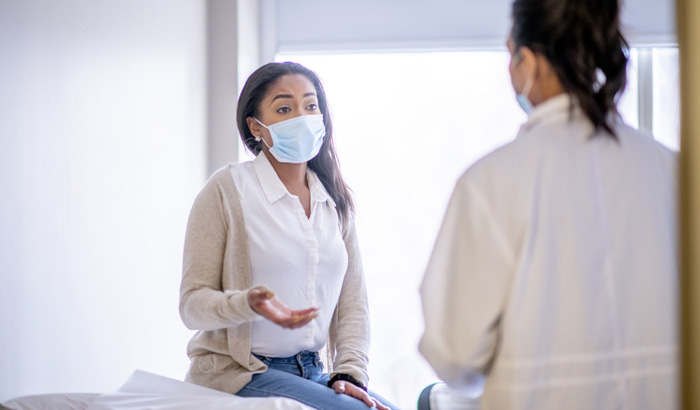Each week the monthly spotlight features a topic-related HSR&D study.
Women Veterans are the fastest growing population seeking VA care1. Currently, there are 1.9 million living women Veterans, who make up 9 percent of the total Veteran population. Every VA medical center has a womem Veterans program manager to advise and advocate for women Veterans. Cervical and breast cancer as well as reproductive and menopausal care are some of the sex-specific programs offered. Mental health programs include those for military sexual trauma (MST), PTSD, and intimate partner violence. Additionally, VA offers services for homeless women Veterans2.
VA supports a comprehensive women's health research agenda, which includes significant contributions from HSR&D. HSR&D oversees development of VA-wide agendas to advance scientific research that includes or focuses on women Veterans to better understand their health and healthcare needs and inform systematic improvements. Access/Rural Health, Complex Chronic Conditions, Deployment Health, Primary Care/Prevention, and Reproductive Health are all highlights of HSR&D women Veterans research3. Below are examples of current research efforts.

©iStock/FatCamera
Implications:
Understanding drivers of women patients’ decisions to use or not use VA is critical for the development of strategies to improve retention of current patients and optimize health outcomes. By examining patient experiences of VA care and assessing patient and system characteristics contributing to attrition, this study has identified subgroups at high risk of attrition. New women patients who are younger merit particular attention to ensure their early experiences with VA are positive, leading them to choose VA for the long term.
Overview:
Women Veterans new to VA are the fastest growing cohort of new VA users, but concerns have been raised about their rate of attrition. Further, there have been many changes in VA healthcare over the past decade, such as a shift to a patient-centered medical home model, the implementation of comprehensive women’s healthcare policy, and expansion of VA-paid community-based care. This study sought to characterize women Veterans’ decision-making related to continuing to use VA or leaving VA care (attrition) – and to explore factors that help retain/attract women to the VA healthcare system. Semi-structured interviews were conducted with 51 women from 2017-2018 and analyzed for women’s decision-making, contexts, and recommendations related to healthcare use. Attrition was defined as having no VA healthcare use, including VA-purchased community care, during years 2 and 3 following the Veteran’s first visit.
Findings:
Publications:
Authors: Joya Chrystal, Cynthia Gammage, Karen Dyer, Jessica Moreau, Donna Washington, Elizabeth Yano, and Alison Hamilton are based at the Center for the Study of Healthcare Innovation, Implementation & Policy (CSHIIP) in Los Angeles, CA. Susan Frayne, Fay Saechao, and Eric Berg are based at the Center for Innovation to Implementation (Ci2i) in Palo Alto, CA.

©iStock/fizkes
Implications:
The lack of evidence-based interventions to address harassment in healthcare settings represents a significant gap in VA’s ability to provide high-quality, gender-sensitive, comprehensive healthcare to women Veterans. This study attempts to address this gap by actively partnering and collaborating with Veterans and other stakeholders to develop and evaluate a novel, Veteran-informed bystander harassment intervention. By addressing harassment and the discomfort it creates, this intervention may reduce disparities in access to and the quality of care for women Veterans.
Overview:
Harassment is a recognized problem in VA facilities. Recent national studies of women Veterans receiving VA health services found that 25% reported experiencing harassment at VA facilities in the past year. Most often, these incidents involved sexual harassment including catcalls, being stared at, and sexual/derogatory comments, or sexist harassment such as someone questioning their identity as a Veteran or their right to care.
Women Veterans who experience harassment are significantly more likely to feel unsafe and unwelcome at VA and to delay or underutilize care, which may place them at risk for poorer health outcomes. Harassment has been shown to negatively impact the dignity, privacy, sense of security, safety, and health of women Veterans. Recognizing this, VA has launched several gender-based harassment initiatives. However, to date, there are no evidence-based interventions to address harassment of service users in healthcare settings such as VA.
The current study attempts to expand VA’s efforts to address harassment by developing and evaluating a bystander activation intervention that can be used to increase awareness of gender-based harassment (GBH) and confidence in and willingness to intervene among Veterans, VA staff, and VA leadership. Specific aims of this study are to:
Twenty women who have experienced harassment and are receiving services at the VA Maryland Health Care System will be creating e “photonarratives” using Photovoice participatory action research (PAR) methods that convey experiences of harassment at VA and its impacts. Investigators are conducting focus groups and individual interviews with male Veterans, female Veterans, and VA staff to inform the adaptation of existing bystander behavior materials for use in a VA setting. The intervention is being developed using these materials and refined over several meetings with Veterans and VA staff and leadership input. A pilot trial of the intervention is in development and will be implemented with Veterans receiving VA mental health care services as well as VA staff.
All participants in the pilot trial will complete a baseline assessment, a qualitative interview at immediate post-intervention, and a 2-week post-intervention assessment. Feasibility and acceptability will be assessed via rates of recruitment, retention, and participant reported acceptability. Outcomes that will be explored include awareness of harassment; recognition of the need to intervene; and responsibility, knowledge, and intent to intervene.
Study Updates:
Principal Investigator: Amy Lynne Drapalski PhD, is an Investigator with the VISN 5 MIRECC at the VA Maryland Health Care System in Baltimore, MD.
Implications:
The long-term objective of this program of research is to advance VA toward efficient and optimal implementation of best practices for treatment of all sleep disorders among women Veterans.

©iStock/KatarzynaBialasiewicz
Overview:
Sleep disordered breathing (SDB) is associated with significant adverse health consequences including cardiovascular disease, motor vehicle accidents, daytime functional impairments, and mortality risk. Although SDB is more common among men than women, it impacts 17% of women in the general population and research suggests it is even more common among women Veterans who receive VA care. The recommended first-line therapy for most patients with SDB is positive airway pressure therapy (PAP). Published studies show that women have lower PAP adherence than men, particularly in the US, yet study investigators are not aware of data comparing men and women Veterans. Because women Veterans experience significant sleep disturbance and other consequences of sleep disorders, adjusting to PAP therapy may be quite difficult. To date, studies have not tested interventions specifically designed to improve PAP adherence among women, accounting for important sleep-related and social factors.
This study seeks to evaluate the application of the Acceptance and the Behavioral Changes to Treat Sleep Apnea (ABC-SA) program in a cohort of women Veterans. ABC-SA is a 5-session program that focuses on the core life values of people with SDB, identifies how use of PAP aligns with the person’s values, then systematically address individual challenges to PAP use.
Specific Aims of this study are to:
Women Veterans 18 years and older, who have received care at the VA Greater Los Angeles Healthcare System, and who have at least 1 risk indicator for SDB are being randomized to receive the ABC-SA program, or a control program modeled after usual care for SDB. Assessment of SDB severity was performed in the participant's home using a WatchPAT sleep apnea testing device. Participants with an Apnea Hypopnea Index (AHI) of 5 or higher with SDB-related symptoms met study inclusion. Additionally, a self-report questionnaire/diary of sleep measures was collected from study participants.
Preliminary Findings:
Publications:
Moghtaderi I, Kelly M ,…Martin J. Identifying Gaps in Clinical Evaluation and Treatment of Sleep Disordered Breathing in Women Veterans. Manuscript under Review.
Principal Investigator: Jennifer L Martin, PhD, is an Investigator with the HSR&D Center for the Study of Healthcare Innovation, Implementation and Policy (CSHIIP) in Sepulveda CA.

©iStock/tommaso79
Implications:
The objective of this study is to develop recommendations to better address the suicide prevention needs of women Veterans who utilize the Veterans Crisis Line (VCL). Findings from this study will be used to develop a set of recommendations for clinical enhancement that operations partners can then implement into policy and practice.
Overview:
The suicide rate among women Veterans has increased substantially in recent years, particularly among younger women and those with limited or no engagement in VA care. VA has invested extensive resources toward preventing suicide among Veterans, including through the Veterans Crisis Line (VCL). Prior research on Veteran suicide prevention and VCL use has focused largely on male Veterans. However, research has identified potentially unique characteristics associated with suicide risk among women Veterans and a need for further investigation into how to best meet the suicide prevention needs of this population. This ongoing study focuses on this understudied and vulnerable population. Investigators will analyze the rich yet largely unexamined data collected by the VCL on user and call characteristics, merge VCL data with VA medical record data for callers who also access VA services, and conduct in-depth interviews with women Veteran VCL users to obtain more detailed understanding of their experiences and perspectives. Findings will inform efforts to better tailor VCL services to, and increase engagement of, high-risk women Veterans.
Specific Aims of this study are to:
For Aim 1, investigators will conduct analysis of VCL data for prior-year Veteran users with identified gender, comparing demographic and VCL contact characteristics by gender. To address Aim 2, VCL data, VA health records, and Suicide Data Repository information will be merged to assess relationships between VCL risk rating and suicidal ideation, suicide attempts, and suicide, with consideration of other health and service utilization characteristics. In Aim 3, investigators will conduct semi-structured telephone interviews with a sample (n = 40) of women Veteran VA patients who have used the VCL, to assess their reasons for contacting the VCL, expectations of VCL, experience with VCL service and connection with follow-up services, and recommendations for improvements in suicide prevention services.
Study investigators will integrate findings with input from a study-specific stakeholder advisory board composed of Veterans and clinical and operations partners, to develop recommendations for enhancing VA’s crisis intervention and broader suicide prevention efforts for women Veterans.
Preliminary Findings:
Study Update:
The study team received additional funding to expand the study to include analysis related to the COVID pandemic through analysis of VCL data from calendar year 2020 and associated outcomes. Dissemination of 2020 VCL call data findings and analysis of outcomes following 2020 calls are ongoing.
Publications:
Dichter M, Krishnamurti L, Chhatre S, et al. Gender differences in veterans' use of the Veterans Crisis Line (VCL): Findings from VCL call data. General hospital psychiatry. December 6, 2021.
Principal Investigator: Melissa E. Dichter PhD, MSW, is an Investigator with the HSR&D Center for Health Equity Research and Promotion (CHERP) in Philadelphia, PA.